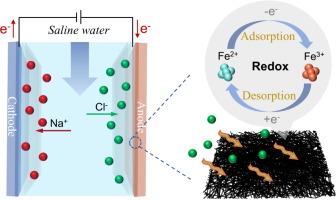Unlocking efficient redox dechlorination through Fe/Fe3C nanoclusters embedded porous carbon nanofibers using capacitive deionization
IF 8.1
1区 工程技术
Q1 ENGINEERING, CHEMICAL
引用次数: 0
Abstract
Development of novel and efficient dechlorination electrodes is essential for improving the capacitive deionization (CDI) performance. Herein, we proposed a hybrid anode material with Fe/Fe3C nanoparticles encapsulated in porous carbon nanofibers (Fe/Fe3C@CNFs) by a polyacrylonitrile (PAN)-based electrospinning strategy and subsequent pyrolysis. The PAN can provide additional carbon resource to induce the generation of Fe3C nanoparticles with higher valence states and hold a confinement environment to prevent the agglomeration of nanoparticles, contributing to the stable and sufficiently exposed redox-active sites. Moreover, the PAN-derived porous carbon nanofibers built a conductive network with abundant cavities and pores to facilitate electron transport. As a result, the CDI dechlorination system of Fe/Fe3C@CNFs delivered an outstanding Cl− removal capacity of 126.4 mg g−1 with a high retention rate of 91.0 % over 30 cycles. The Cl− adsorption mechanism of Fe/Fe3C@CNFs was proved to originate from the fast surface transformation reaction of the reversible Fe2+/Fe3+ redox couple, demonstrating its great potential as a superior pseudocapacitive electrode for CDI dechlorination. This study provides guidance on the construction of high-performance Cl-storage electrode for water remediation.


求助全文
约1分钟内获得全文
求助全文
来源期刊

Separation and Purification Technology
工程技术-工程:化工
CiteScore
14.00
自引率
12.80%
发文量
2347
审稿时长
43 days
期刊介绍:
Separation and Purification Technology is a premier journal committed to sharing innovative methods for separation and purification in chemical and environmental engineering, encompassing both homogeneous solutions and heterogeneous mixtures. Our scope includes the separation and/or purification of liquids, vapors, and gases, as well as carbon capture and separation techniques. However, it's important to note that methods solely intended for analytical purposes are not within the scope of the journal. Additionally, disciplines such as soil science, polymer science, and metallurgy fall outside the purview of Separation and Purification Technology. Join us in advancing the field of separation and purification methods for sustainable solutions in chemical and environmental engineering.
 求助内容:
求助内容: 应助结果提醒方式:
应助结果提醒方式:


